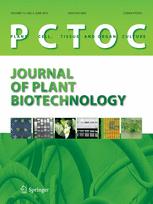Ver ítem
- xmlui.general.dspace_homeCentros e Institutos de InvestigaciónCIAP. Centro de Investigaciones AgropecuariasInstituto de Fisiología y Recursos Genéticos VegetalesArtículos científicosxmlui.ArtifactBrowser.ItemViewer.trail
- Inicio
- Centros e Institutos de Investigación
- CIAP. Centro de Investigaciones Agropecuarias
- Instituto de Fisiología y Recursos Genéticos Vegetales
- Artículos científicos
- Ver ítem
Somatic embryogenesis from in vitro anther culture of apomictic buffel grass genotypes and analysis of regenerated plants using flow cytometry
Resumen
Buffel grass is a fodder grass that reproduces mainly via apomixis. Using in vitro tissue culture in apomictic species provides alternatives that can be applied in a breeding program. The aims of this work were to establish a protocol for in vitro generation of apomictic buffel grass genotypes using anthers as explants and to evaluate the genetic stability of regenerated plants via flow cytometry (FCM). Three genotypes were able to induce embryogenic
[ver mas...]
Buffel grass is a fodder grass that reproduces mainly via apomixis. Using in vitro tissue culture in apomictic species provides alternatives that can be applied in a breeding program. The aims of this work were to establish a protocol for in vitro generation of apomictic buffel grass genotypes using anthers as explants and to evaluate the genetic stability of regenerated plants via flow cytometry (FCM). Three genotypes were able to induce embryogenic calli in Murashige and Skoog (MS) medium supplemented with 6 mg/l of 2,4-dichlorophenoxyacetic acid. Seedling regeneration occurred in a MS medium supplemented with 0.5 mg/l napthaleneacetic acid + 1 mg/l 6-benzylaminopurin. Seedlings were derived from somatic embryos and the morphogenic process was induced using the somatic tissue of the stamens. Induction and regeneration efficiency depended on the genotype and was affected by date of tiller collection, different pretreatments or the interaction of these variables. FCM analyses in in vitro regenerated plants showed genetic instability in their nuclear DNA content. Plants with lower nuclear DNA content may indicate DNA aneuploids (8.6 %), whereas plants that had twice the value of nuclear DNA content (4.7 %) suggest in vitro polyploidization. This variation observed in apomictic genotypes provides an opportunity to obtain new variants, which may then be included as sources of genetic variability in buffel grass breeding programs.
[Cerrar]

Fuente
Plant cell, tissue and organ culture 117 (3) : 311-322. (2014)
Fecha
2014-06
ISSN
0167-6857
1573-5044 (Online version)
1573-5044 (Online version)
Formato
pdf
Tipo de documento
artículo
Palabras Claves
Derechos de acceso
Restringido
 Excepto donde se diga explicitamente, este item se publica bajo la siguiente descripción: Creative Commons Attribution-NonCommercial-ShareAlike 2.5 Unported (CC BY-NC-SA 2.5)
Excepto donde se diga explicitamente, este item se publica bajo la siguiente descripción: Creative Commons Attribution-NonCommercial-ShareAlike 2.5 Unported (CC BY-NC-SA 2.5)

